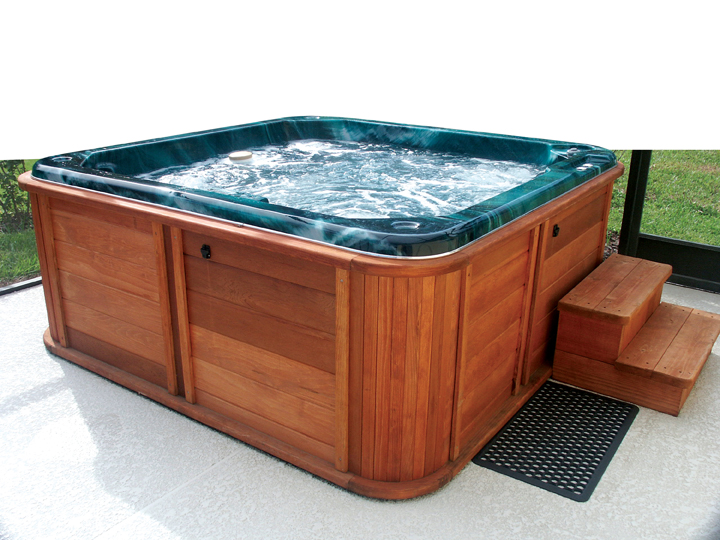Soaking for Good Health
By Nancy Moffett
Oh, the woes of life in the 21st century…arthritis, bursitis, aching muscles, cranky back, stressful days and sleepless nights. Long ago, our ancestors discovered they could relieve these and other ailments by soaking in hot springs. In the United States, resort hotels and towns grew up around these watery retreats.
According to the Arthritis Foundation, “The soothing warmth and buoyancy of warm water make it a safe, ideal environment for relieving arthritis pain and stiffness. Immersing in warm water raises your body temperature, causing your blood vessels to dilate and increasing circulation…using a spa* adds a component to the therapy – massage. Jet nozzles release warm water and air, massaging your body and helping you relax tight muscles.”
No need to travel to take advantage of the healing properties of hot water these days. Having a home spa is no longer an expensive luxury. There are tons of options that will allow you to soak your aches and pains away at home.
Taking the Plunge
The best way to begin your search for the ideal spa is to visit several dealers. Figure out what size you need for the number of people who will use it and where you want it placed. Roger Kornseind, general manager for Olympia Pools of Whitehall, urges customers to sit in display spas to judge comfort and find the best jet configuration. After you’ve narrowed down the search, some dealers will arrange a return visit with the spa filled so you can feel firsthand how it works for your size and trouble spots.
John Laputka, owner of Dr. Feelgoode’s, advises customers to consider which muscle groups need relief and make sure jets line up correctly for your problem areas. “We carry more than one line in order to find the one that works best for each customer,” he says. Jets function by either rotating or pulsating, and may include ones that pulsate up and down the vertebrae, target wrists, the back of the knee and the feet.
Ken Janowicz, sales manager for Kasper’s Pool Supplies and Spas, concurs. “Most spas go outdoors, while others are installed in a master suite or sun room” he notes. “Not only do you need the right spa, but you also have to have a suitable site.” To that end, most dealers will do site inspections to insure the tub will fit and that the proper electrical service is available. The line Kasper’s carries, Bullfrog, has interchangeable JetPaks® (sets of jets) that can be moved from seat to seat, including when the spa is filled, for a more custom experience.
New twists on the typical acrylic, portable spa include salt water or mineral technology and metallic silver finishes that eliminate use of chlorine and bromine for those with sensitivity problems. “It’s important to have the correct chemical set-up to avoid such things as sinus problems,” Janowicz explains.
There is another option other than the portable spa. If you’re planning to add an in-ground pool to your property, consider including an attached spa. Keith Bodziuch, purchasing agent for Barry Bartakovits Custom Pools, says this type of spa is more for aesthetics than health, but offers a different kind of outdoor hot water experience. “This is a permanent structure that can be any shape or size you want.” It’s framed then finished with rebar and concrete and has fixed jets. “Do it all at one time,” he recommends, noting that in-ground spas range in price from $7,000 to $15,000.
Cost
Although there are low-end spas on the market, these are usually targeted to first-time buyers who are more interested in enjoyment than therapy. Costs begin around $1,999 for a two-to-three-person inflatable. More traditional, warranted spas start at about $3,999, according to Laputka, with a high-end 92” x 92” with TV, stereo, LED lighting and water features coming in at about $15,000.
With engineering and insulation advancements, today’s spas are more thermally efficient than older models. According to Kornseind, a six-to-seven-person spa will average $20 to $30 a month to run over all seasons. The Artesian® brand carried by Olympia earned a high efficiency rating by the California Energy Commission. Other brands carried by Lehigh Valley dealers have also been reviewed by the Commission. Before you decide, make sure you understand what the long term costs will be, and expect the dealer to walk you through these important issues before you make a decision.
Maintenance
“Spas are easier to maintain than pools,” says Janowicz, “as they react quickly when you add chemicals.” And, chemical measurements are in teaspoons or tablespoons, not gallons. However, keeping chemicals balanced is important, as bacteria will grow faster in hot water than in a pool, says Bodziuch. Filters need to be cleaned frequently if the spa is heavily used. And, spas need to be drained, cleaned and refilled every three to four months. Your spa dealer should help you set up the water initially and educate you on maintaining proper water balance.
One of the most enjoyable aspects of a home spa is being able to soak outdoors during the cold months, says Laputka. Romantic, therapeutic and soothing…there’s something wonderful about soaking in a spa on a winter evening with snowflakes falling all around you.
*The terms spa and hot tub are mostly interchangeable, while Jacuzzi® refers to a particular brand.
Nancy Moffett knows firsthand the healing properties of hot water. Not only did hydrotherapy help her recover from polio in 1950, but her home spa also helps her cope with the disease’s aftereffects (Post Polio Syndrome) today.





